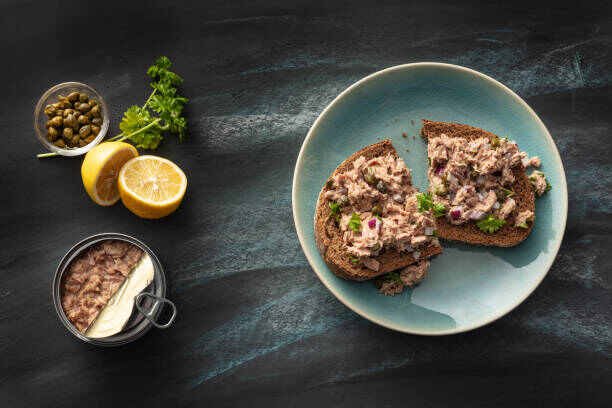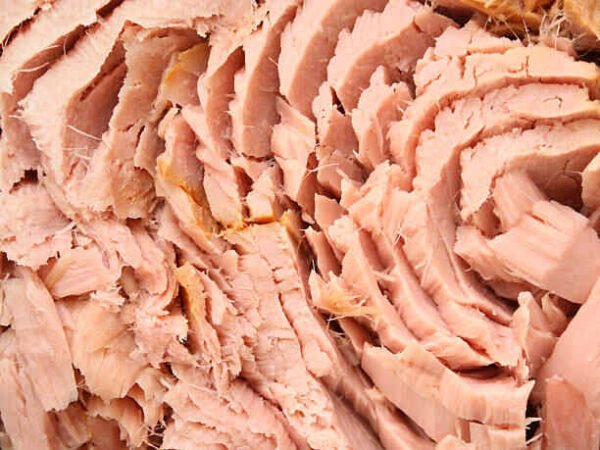Can kittens Have Tuna? Everything You Should Know About Benefits – Risks – How to Feed

You may have heard that giving kittens tuna is unsafe, but is that true? Can kittens have tuna?
Kittens can have tuna but in small quantities, occasionally from 5 weeks old. Tuna has a huge mercury load that could lead to mercury poisoning in kittens, mainly if you feed your kitty lots of tuna. The most preferred type of tuna to give your cat is the bluefin, which has lesser mercury content.
In this article, we have written about everything you need to know about your question on “can kittens have tuna?” Benefits, risks, symptoms, and how to resolve them, plus a Homemade tuna cat treat recipe.
Table of Contents
- What Is Tuna?
- Can Kittens Have Tuna?
- Is Tuna Good for Kittens?
- What Are the Risks of Feeding Kittens Tuna
- How Much Tuna Can Kittens Eat
- How to Prepare Tuna for Kittens
- What Are Some Alternative Foods for Kittens?
What Is Tuna?
Tuna is a saltwater habitat, they belong to the Thunnini tribe( a subgroup of the mackerel family). This tribe is made up of 15 species and five genera, of which most fall under the genus Thunnus.
From a culinary standpoint, two types of tuna are important bluefin and albacore. The bluefin is characterized by its flashy red loins. which could be made into tasty steaks or could be transformed into sushi when cut into strips. The Albacore is usually flaky and pale when it has been packed into cans.
Tina’s are amazing swimmers who migrate through the world, hitting a speed of 75mph. A unique trait of tunas is their ability to have a body temperature higher than that of any water they find themselves in.
Can Kittens Have Tuna?

A kitten’s diet requires that, once the kitten is weaned off her mother’s milk, her growth into a healthy adult depends on what she eats, this is why you have to monitor her food closely. For every age group in kittens, there are specific foods needed to help them into the next stage—these are the foods you should feed them.
Kittens require animal protein-based diets, this is crucial to their energy need, as they require energy 3 times what an adult cat will require. Canned tuna that is made specifically for humans are not made to cater to a kitten’s dietary needs, this is why your kitten shouldn’t eat canned tuna.
Letting your kitten have some canned tuna may not bring about harm, but it is better to feed your cat fresh tuna. My five-week-old kitten had no issue eating little tuna twice a week(this is the same time at which kittens can eat dry kibbles), you should understand I have advanced knowledge of cats’ dietary needs, so I know how to prepare fresh tuna healthily—ill be showing you how I prepare tuna for kittens in subsequent sub-headings.
Is Tuna Good for Kittens?
When kittens try out tuna for the first time, most of them become addicted. I have come across cases when the juvenile cats refused to eat anything else except TUNA. While a little tuna won’t hurt but never try to make it your kitten’s major meal.
Cats require taurine and tuna is an excellent source of taurine, according to WebMD. Taurine is very important in cats since it aids brain, heart, and vision function, deficiency of taurine could lead to heart failure or complete loss of vision in cats(blindness).
Tuna contains Vitamin B6 (pyridoxine) which is a water-soluble vitamin. Vitamin B6 plays a crucial role in making hormones, proteins, and neurotransmitters which are chemicals that transmits signals between nerve cells. Due to cats’ high transmitter activity as a result of their high protein requirements, kittens need Vitamin B6.
Tuna also contains high omega-3 fatty acids, potassium, magnesium, Vitamin C, calcium, iron, and Cobalamin. This means tuna can do your kittens a lot of good, but stick to fresh tuna, which you have to prepare yourself and feed in moderation, as kittens can get addicted fast.
What Are the Risks of Feeding Kittens Tuna
Tuna has lots of nutrients that could be great for cats, but it also contains lots of harmful compounds that can affect your cat’s health. Mercury, high cholesterol, allergen reaction, and high sodium.
Tuna is high in mercury, a metal that is toxic for cats. If your cat consumes too much tuna, this will lead to mercury poisoning according to Heinze a veterinarian at Tufts University. If your cat has been poisoned by mercury, you’ll notice the following signs loss of coordination and dizziness. “The albacore tuna should be avoided by all means because it has 3 times as high mercury in chunk lights,” says Cailin Heinze.
Kittens can be allergic to tunas and fish in general. Fish causes the most food allergic reaction in cats according to Merck Veterinary. Food allergen is when the kitten’s immune system reacts to a specific protein found in foods says Ryan Llera of VCAhospital. Signs of allergic reactions you may notice in your kittens include red bumps, hair loss, itching, vomiting, loss of appetite, and diarrhea. If you notice any of these signs, speak with your vet.
Propensity to gain abnormal weight, your indoor cats have a high propensity to gain unnecessary weight just by consuming tuna. Obesity in cats is said to occur when a cat is 20% over its body weight according to Cornell university college of vegetarian medicine. A can of tuna contains over 100 calories, and a kitten only requires 20 calories per pound. Giving a six-pound kitten a can of tuna and nibbles will only lead to obesity.
Monitoring what your cat eats will ensure your cat leads a healthy life. Take the pain to check for calorie information on their foods, and ensure to feed your cat what is good for their body.
Yellow fat disease: feeding a kitten large amounts of canned tuna can pose a significant health risk for your bet. Yellow fat (steatosis) is common in kittens According to Merck Veterinary Manual the key signs to look out for are abdominal pains, weight loss, loss of appetite, and fever. Get your vet involved as soon as you notice these signs.
How Much Tuna Can Kittens Eat
Before you give your kitten tuna, consult with your vet; you will be provided with the appropriate serving quantity, and advice they will also let you know how often you should give your kitten tuna.
If your vet okays giving your cat tuna, you have to test if it’ll have allergic reactions by giving it small amounts, if you notice any signs of allergic reactions or illness, discontinue feeding the cat tuna.
Tuna should be used as a treat sometimes, you shouldn’t make it a major food. Mix the tuna in the cat’s regular food. A teaspoon of tuna one to three times a week is okay, it should be an insignificant portion of their meals.
You can serve your cat fresh tuna( make sure it’s void of spice and boneless) or canned tuna, but make sure there are no extra additives and it’s real tuna in water.
How to Prepare Tuna for Kittens
In preparing tuna for cats, there are lots of things you can try provided it’s grain, dairy, and gluten-free. My idea for this homemade tuna cat treat was born out of my cat’s addiction to tuna, I knew very well that I can’t make tuna it’s a regular diet, so I had to think of a way to turn the tuna to cat treats.
I try to avoid commercial treats if I can because I have a feeling that the companies are not entirely sincere about the ingredients used. So, I like to take control of what goes into my cat.
Homemade Grain-free Tuna Cat Treats
Ingredients
- 1 egg
- Slice of fresh tuna or 1 tin tuna in spring water.
Here’s the recipe for a homemade tuna cat treat that’s safe for kittens:
- Line a baking sheet with a greaseproof and preheat your oven to 170C/330F.
- Crack the eggs open, and separate the yolks from the white. Do away with the yolks and turn the whites into your mixing bowl.
- Forming stiff peaks by whisking the egg with your hand or an electric whisk.
- Empty the can/slice of tuna into the bowl of your blender. Add two tablespoons of the whisked eggs into the tuna, then blend until there are no lumps or flakes( in the past that should be smooth at this point).
- With the use of a spatula, take out the tuna mixture from your blender’s bowl, then mix with the remaining egg white.
- To give the treats any shape you want, make use of anything that will give you the desired shape you’re aiming for— use a piping bag with a small star nozzle attachment to make my shapes.
- Now is the time to bake, place in your oven for 25 minutes, when the treats easily come off the baking papers or feel dry when you touch them—it’s done! Take it out and let it cool, then transfer it to an air-tight zip bag or jar. Shelf life is two weeks.
What Are Some Alternative Foods for Kittens?
If you’re looking for a healthy, non-tuna-based diet for your kitten, you’ve come to the right place. While tuna is a popular food choice for kittens, it’s not the only one.
There are plenty of other foods that are just as nutritious – and sometimes even more so – than tuna. In this section, we’ll explore some of the best alternative foods for kittens.
Chicken
A great alternative to tuna is chicken. Most supermarkets sell chicken breast for a very reasonable price, and your cat will love the taste. If you’re looking for something even cheaper, you can always go for canned chicken – just make sure it’s plain chicken, with no added sauces or spices.
Salmon
Salmon is one great alternative. It’s low in mercury and has plenty of Omega-3 fatty acids, which are crucial for kitten development. Plus, it’s a tasty choice that most kittens will love.
If salmon isn’t your kitten’s thing, there are plenty of other options to choose from. Some good ones include trout, cod, and whitefish. Just be sure to avoid any fish that are high in mercury, like shark or swordfish
Turkey
Turkey is high in protein and low in fat, which makes it a perfect choice for kittens. Plus, it’s easy to digest and won’t cause any stomach problems. Turkey necks can be used to keep your cat’s breath fresh, especially if they hate the toothbrush.
So if you’re looking for an alternative to tuna, turkey is a great option. Just be sure to give your kitten plenty of water, since turkey is a bit dry.
Kibble
This is not an alternative, it is necessary! There are a lot of different kibble brands out there, so you can choose the one that’s best for your kitten. Just make sure to read the label and make sure the kibble is stamped with a nutritional certification from the Association of American Feed Control Officials (AAFCO).
And don’t forget about the water! Kittens need plenty of fresh water to stay hydrated, so make sure to keep a bowl of water nearby at all times.
Can Kittens Eat Tuna? Final Thoughts
Be sure to only give your kitten a small amount of tuna at first and see how they react. If everything seems to be going well, you can gradually increase the amount of tuna in their diet. Just be sure to keep an eye on their health and weight, and consult your veterinarian if you have any concerns.



